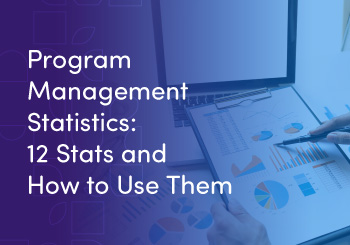 From smaller, newer nonprofits to larger charitable organizations, measuring performance is a universally shared need, especially in the realm of fundraising.
From smaller, newer nonprofits to larger charitable organizations, measuring performance is a universally shared need, especially in the realm of fundraising.
But for organizations that offer direct services to constituents, such as social services nonprofits, there’s another layer of complexity—impact measurement. When you manage constituent relationships, interactions, and outcomes through a case management process, understanding the key data points at play will allow you to analyze the bigger picture of your performance over time.
We’ll walk you through some basic program management statistics for your organization’s impact measurement in the following sections:
- Understanding Program Management Statistics
- 12 Key Impact Statistics
- How to Choose the Right KPIs
By incorporating key performance indicators (KPIs) into discussions on your nonprofit’s future, you’ll benefit from improved communications with stakeholders and more informed decisions for constituents moving forward.
Understanding Program Management Statistics
Whether you’re assessing future needs or composing an annual report to share with donors, funders, and community members, conducting impact assessment is crucial for tracking progress and driving continued on-the-ground impact.
By collecting essential metrics as part of your program management process, you’ll be able to use this information to:
- Identify program gaps and areas of need. Using predefined metrics can be incredibly valuable for determining how well your nonprofit has been meeting the needs of your constituents and where you can adjust for greater impact. For example, a nonprofit offering services to the formerly incarcerated may analyze recidivism rates and tweak its programs to offer improved counseling and intervention solutions.
- Project your future needs and allocate resources accordingly. Once you’ve examined the current impact of your organization, you can work with these metrics to aim for future goals and improvements. As you proceed, you’ll have concrete methods for measuring the efficacy of your changes.
- Demonstrate value and impact to funders, donors, board members, and more. Your donors and stakeholders want to be in the loop. Kwala’s tactics for donor communications highlights the significance of regular updates and nonprofit news for strengthening their involvement in your cause. Funders may also explicitly ask for impact assessment data as part of their grant application and reporting processes.
As you work closely with your constituents, be sure to keep stakeholders such as board members connected with your goals by updating them with easy-to-follow impact data.
In many cases, however, the impact you’re driving may not be very tangible or easily quantified. Approaching impact positions from this perspective may seem uniquely complex, but by first understanding what you’re looking for and why, you can set your team up for success.
12 Key Impact Statistics
As you begin thinking about impact metrics for your organization, keep in mind that the ones you choose will depend on your goals and mission. What do you absolutely need to know in order to better do your job or satisfy funder requirements?
At this stage, it can also be helpful to encourage input from your constituents, staff, and board members. They’ll likely be able to provide more diverse insights to identify which metrics will be most valuable and relevant to your nonprofit’s on-the-ground work.
To get started, review these three general categories of impact statistics:
Foundational Impact Statistics
These statistics should form the basis of your impact assessment. These metrics can provide core data that will enable you to measure the difference your organization is making in your community.
- Constituents Served. This key performance indicator (KPI) quantifies the number of constituents served or affected by your program or initiative. Having this information can be useful to share the general scope of impact that your activities have had on clients and beneficiaries.
- Services Delivered. Related to the previous metric, this data captures the services your nonprofit delivered to its constituents in a quantifiable manner. For instance, an emergency assistance organization could track delivering 5,500 meals and 200 medical kits in one month.
- Diversity Metrics. You can measure the diversity of your organization’s stakeholders and participants to acquire a deeper understanding of the foundation that empowers your programs. You can take a certain group such as your volunteer team and measure their average age or cultural background. Collecting diversity metrics also enables you to ensure you achieve equitable outcomes among the diverse individuals who benefit from your programs.
- Stakeholder Satisfaction. This is a qualitative rather than quantitative measurement for your nonprofit impact. Make use of interviews, assessments, and questionnaires to collect data for this metric.
These may seem like a lot to keep track of, but implementing a comprehensive nonprofit impact measurement platform can streamline the process. Assemble and track collected data from surveys, assessments, and interviews all in one place to efficiently manage your foundational impact statistics and more.
Statistics for Measuring Success
 Now that you have a foundation of data to analyze the current state of your organization and its efforts, it’s time to focus on some specific statistics that can measure the success of your programs or services.
Now that you have a foundation of data to analyze the current state of your organization and its efforts, it’s time to focus on some specific statistics that can measure the success of your programs or services.
- Constituents Demonstrating a New Behavior/Skill. This metric will allow you to definitively calculate the impact of your nonprofit’s efforts by noting positive changes in your beneficiaries. To get this number, divide the number of constituents demonstrating a new behavior/skill by the total number of constituents taught that new behavior/skill. Then multiply that number by 100 to get the percentage.
- Constituent-Reported Improvements. Make use of tools such as interviews and surveys to allow your constituents to directly communicate your program’s impact on specific areas of their lives, whether that’s social, health, or economic. For instance, a high school student could report acquiring a part-time job after learning leadership skills from a youth program.
- Returning Constituents. Further measure the impact of your service or program by calculating the number of constituents who returned to benefit from it again. For example, an addiction recovery nonprofit could note 14 people returning for its long-term peer support program last December.
- Reduction in Undesirable Behavior. You could calculate this metric as a percentage to get a better understanding of the rate of undesirable behavior from constituents after involvement in a program. Measuring relapse or recidivism rates among participants and comparing them against other data points (like demographic information or the timeframes in which they received services) can reveal actionable improvements you should make to better serve the community.
These statistics can be valuable additions to updates in your organization’s email newsletter to donors and supporters. Encourage your stakeholders by providing them with concrete data illustrating the impact of their efforts.
Financial and Internal Statistics
Lastly, this category covers metrics that can be very informative for your nonprofit’s operations and program planning. By collecting data that measures the effectiveness of organization efforts, you’ll be much better equipped to optimize your strategies over time.
- Cost Per Successful Outcome. Success differs for each organization. Take a look at your goals and determine how much money it took to reach each one. This metric is similar to cost-per-dollar-raised, a common fundraising metric. You could calculate this at the end of a program by dividing its associated expenses by its number of successful outcomes, depending on how you define success.
- Overhead Costs versus Program Costs. This metric will allow you to examine the resources you allocate to operation and administrative necessities compared to funds devoted directly to programs. These numbers will help inform your budgets for the future.
- Average Donation Size. You can measure the average donation amount from supporters by dividing the total gift amount by the number of gifts received in a specific time frame and/or by donor segment. This data can be immensely useful when appealing to donors or implementing suggested giving amounts to your donation page.
- Fundraising ROI. This KPI measures the amount of money your organization raised compared to the amount of money you invested into fundraising. Calculate this rate to determine how and where you can update your fundraising strategy for greater results.
With your stakeholders, examine these categories and suggested metrics to determine which are most relevant and helpful for your organization. Be sure to take advantage of the wealth of insights that regularly collecting and analyzing data can offer.
How to Choose the Right KPIs
 There are dozens of metrics that you can use to measure your organization’s impact. With that in mind, it’s important to be deliberate and thoughtful when choosing the data you’d like to gather.
There are dozens of metrics that you can use to measure your organization’s impact. With that in mind, it’s important to be deliberate and thoughtful when choosing the data you’d like to gather.
Consider the following factors for determining the right metrics for you:
- Relevance. Ensure that your KPIs align with your organization’s mission, values, and needs.
- Utility. Which metrics will contribute to specific goals for your nonprofit, such as grant reporting, fundraising, or donor outreach?
- Timeliness. Your impact metrics should be regularly collected and updated to maintain their effectiveness.
- Cost. Check your budget and resources when determining the types and amounts of data you’d like to collect.
Be sure that you can effectively and efficiently gather, analyze, and share your collected data. Whether you’re seeking ways to tweak your program planning or communicate your nonprofit’s impact on social media, these metrics are essential for success.
The Bottom Line
Impact measurement can contribute valuable data when you apply for grant funding. Your metrics can also serve as a strong basis for communicating your organization’s mission and goals to the world. SureImpact’s guide to building an impact story emphasizes the importance of humanized impact data to enhance the power of your nonprofit’s personal stories.
When you work to provide services and direct help to constituents, impact metrics can usher in exciting opportunities for your organization to learn from the past and report on your victories. Good luck!
About the Author
 Sheri Chaney Jones
Sheri Chaney Jones
President & CEO of SureImpact
For more than 20 years, Sheri Chaney Jones has applied performance management, evaluation, and organization behavior best practices to non-profit organizations and government agencies to improve outcomes and efficiencies. An author, professor, and internationally recognized expert, Sheri believes in data, metrics, and accountability.
Sheri’s foray into entrepreneurship began with Measurement Resources Company in 2010. Now a national firm, Measurement Resources increases the capacity of non-profit and government sector organizations through high-performance practices and data-driven insights. In 2018, Sheri launched SureImpact to automate and simplify the process of collecting and sharing outcomes and impact data.
Sheri is a thought leader on public sector evaluation and applied organizational research. She is the author of Impact & Excellence: Data-Driven Strategies for Aligning Mission, Culture, and Performance in Nonprofit and Government Organizations (Jossey Bass, 2014).
Sheri is passionate about women’s equity and the advancement of girls. She is the Columbus Chapter President of the National Association of Women Business Owners and a Commissioner for the Columbus Women’s Commission for the Mayor’s Office.






Leave A Comment